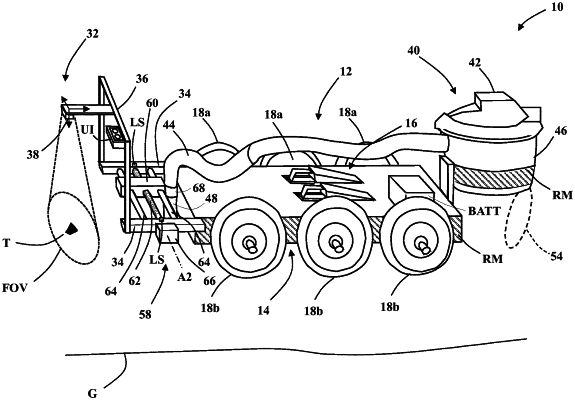| CPC E01H 1/0836 (2013.01) [A47L 9/2842 (2013.01); A47L 9/2852 (2013.01); A47L 2201/04 (2013.01); A47L 2201/06 (2013.01)] | 8 Claims |

|
1. A robotic system for collecting trash along a beach, the robotic system comprising:
a vehicle including a frame and a drive;
a camera coupled to the vehicle to move with the vehicle to capture images of the trash while the vehicle moves along the beach, wherein the camera has a camera coordinate system fixed relative to the frame;
a trash collection unit carried by the vehicle to collect the trash, the trash collection unit including a vacuum pump and a collection conduit having a vacuum head for positioning adjacent to the trash to collect the trash,
wherein the trash collection unit further includes a trash canister having a plurality of material separation screens to retain the trash in the trash canister, a movable bottom to release sand that is sized to pass through the plurality of material separation screens, and a dump motor operatively coupled to the movable bottom to selectively open and close the trash canister;
an actuator operatively coupled to the collection conduit to adjust a position of the collection conduit relative to the vehicle to position the vacuum head of the collection conduit adjacent to the trash to collect the trash, wherein the actuator includes a carriage, a drive screw, a stepper motor, and limit switches; and
a controller coupled to the drive, the camera, the trash collection unit, the dump motor, and the actuator to coordinate movement of the vehicle, positioning of the collection conduit relative to the vehicle based on the images of the trash captured by the camera, operation of the dump motor to periodically release the sand from the trash canister, and operation of the vacuum pump to collect the trash;
wherein the controller is configured to:
calibrate the actuator by adjusting the carriage to each end of the drive screw until the limit switches are engaged by the carriage to determine a current location of the vacuum head in the camera coordinate system;
operate the drive of the vehicle so that the vehicle moves at a vehicle velocity along a predefined path on the beach;
identify the trash in the images of the trash captured by the camera and assign coordinates to the trash in the camera coordinate system as the vehicle moves along the predefined path;
determine target coordinates for the vacuum head in the camera coordinate system based on a relationship between the coordinates assigned to the trash and the current location of the vacuum head;
calculate, based on the vehicle velocity, a commanded time to activate the vacuum pump and a commanded velocity of the vacuum head needed to reach the target coordinates in time to collect the trash;
determine if the commanded velocity exceeds a maximum velocity of the vacuum head and if the commanded velocity does not exceed the maximum velocity, adjust the position of the vacuum head relative to the vehicle at the commanded velocity while the vehicle is moving along the predefined path, so that the vacuum head is positioned at the target coordinates adjacent to the trash to collect the trash at the commanded time;
activate the vacuum pump at the commanded time when the vacuum head reaches the trash to collect the trash;
deactivate the vacuum pump a predetermined amount of time after activating the vacuum pump to ensure that the trash is collected;
evaluate an elapsed time since the dump motor was operated to release the sand; and
determine if the elapsed time is greater than a predefined threshold time and if the elapsed time is greater than the predefined threshold time, operate the dump motor to release the sand.
|